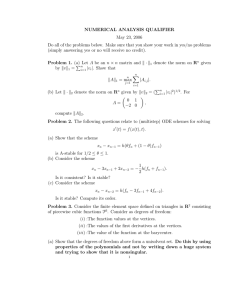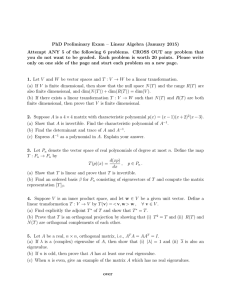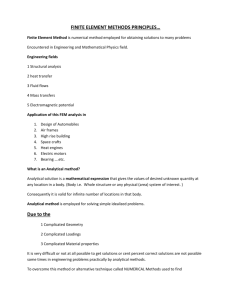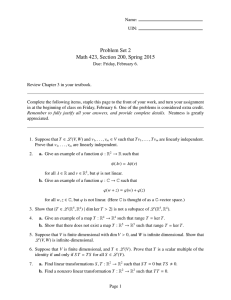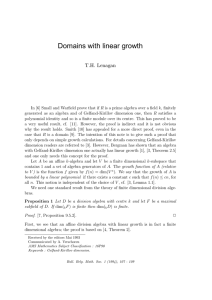NUMERICAL ANALYSIS QUALIFIER January, 2007
advertisement
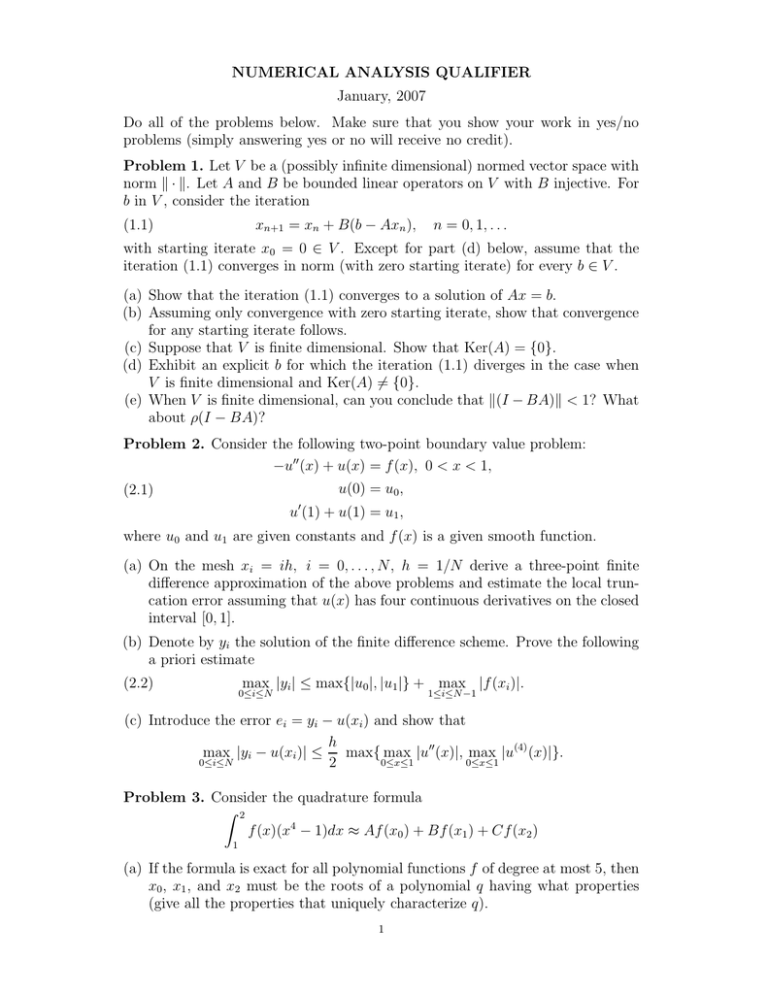
NUMERICAL ANALYSIS QUALIFIER
January, 2007
Do all of the problems below. Make sure that you show your work in yes/no
problems (simply answering yes or no will receive no credit).
Problem 1. Let V be a (possibly infinite dimensional) normed vector space with
norm k · k. Let A and B be bounded linear operators on V with B injective. For
b in V , consider the iteration
(1.1)
xn+1 = xn + B(b − Axn ),
n = 0, 1, . . .
with starting iterate x0 = 0 ∈ V . Except for part (d) below, assume that the
iteration (1.1) converges in norm (with zero starting iterate) for every b ∈ V .
(a) Show that the iteration (1.1) converges to a solution of Ax = b.
(b) Assuming only convergence with zero starting iterate, show that convergence
for any starting iterate follows.
(c) Suppose that V is finite dimensional. Show that Ker(A) = {0}.
(d) Exhibit an explicit b for which the iteration (1.1) diverges in the case when
V is finite dimensional and Ker(A) 6= {0}.
(e) When V is finite dimensional, can you conclude that k(I − BA)k < 1? What
about ρ(I − BA)?
Problem 2. Consider the following two-point boundary value problem:
−u′′ (x) + u(x) = f (x), 0 < x < 1,
u(0) = u0 ,
(2.1)
′
u (1) + u(1) = u1 ,
where u0 and u1 are given constants and f (x) is a given smooth function.
(a) On the mesh xi = ih, i = 0, . . . , N, h = 1/N derive a three-point finite
difference approximation of the above problems and estimate the local truncation error assuming that u(x) has four continuous derivatives on the closed
interval [0, 1].
(b) Denote by yi the solution of the finite difference scheme. Prove the following
a priori estimate
(2.2)
max |yi| ≤ max{|u0 |, |u1|} + max |f (xi )|.
0≤i≤N
1≤i≤N −1
(c) Introduce the error ei = yi − u(xi ) and show that
h
max |yi − u(xi )| ≤
max{ max |u′′ (x)|, max |u(4) (x)|}.
0≤x≤1
0≤x≤1
0≤i≤N
2
Problem 3. Consider the quadrature formula
Z 2
f (x)(x4 − 1)dx ≈ Af (x0 ) + Bf (x1 ) + Cf (x2 )
1
(a) If the formula is exact for all polynomial functions f of degree at most 5, then
x0 , x1 , and x2 must be the roots of a polynomial q having what properties
(give all the properties that uniquely characterize q).
1
2
(b) Which of these polynomials is orthogonal to P2 on the interval [0, 1] with
weight function w(x) = 1? p1 (x) = 1 + x, p2 (x) = x − 12 , p3 (x) = x2 − 3x + 1,
p4 (x) = 35x4 − 60x2 + 32x − 3, p5 (x) = x3 − 3x2 + x − 1.
(c) Show that the coefficients A, B, C of this formula are all positive.
(d) If f ∈ C 6 [1, 2] give an estimate for the error for the quadrature formula.
Problem 4. Let K be a nondegenerate triangle in R2 . Let a1 , a2 , a3 be the
three vertices of K. Let aij = aji denote the midpoint of the segment (ai , aj ),
i, j ∈ {1, 2, 3}. Let P be the set of the polynomial functions obver K of total
degree at most 2. Let Σ = {σ1 , σ2 , σ3 , σ12 , σ23 , σ31 } be the linear forms (or degrees
of freedom) on P defined such
σi (p) = p(ai ), i ∈ {1, 2, 3}
σij (p) = p(ai ) + p(aj ) − 2p(aij )
(a) Show that (K, P, Σ) is a finite element.
(b) Compute the basis of P which the dual of {σ1 , . . . , σ31 } (use the barycentric
coordinates λ1 , λ2 , λ3 ).
(c) Evaluate the entry m11 of the element mass matrix.
Problem 5. Given the initial value problem for the homogeneous hyperbolic
equation in one dimension: Find u(x, t) such that:
∂2u ∂2u
− 2 =
∂t2
∂x
0,
0 < x < 1, t > 0,
u(0, t) = u(1, t) =
0,
t > 0,
u(x, 0) = f (x),
∂u
(x, 0) = g(x),
∂t
0 < x < 1.
(a) Derive the weak formulation and its semi-discrete Galerkin approximation
using piecewise linear finite elements on a uniform spatial mesh xi = ih,
i = 0, 1, . . . , N with h = 1/N. What would be the appropriate energy type a
priori estimate for the semi-discrete Galerkin solution?
(b) Derive a fully discrete explicit approximation on a grid tn = nk by replacing
the time derivative by the three-point finite difference in time and lumping
the “mass” matrix. Using the Fourier method show that this scheme is stable
if k ≤ h. Here k and h are, respectively, the step-sizes in time and space.


